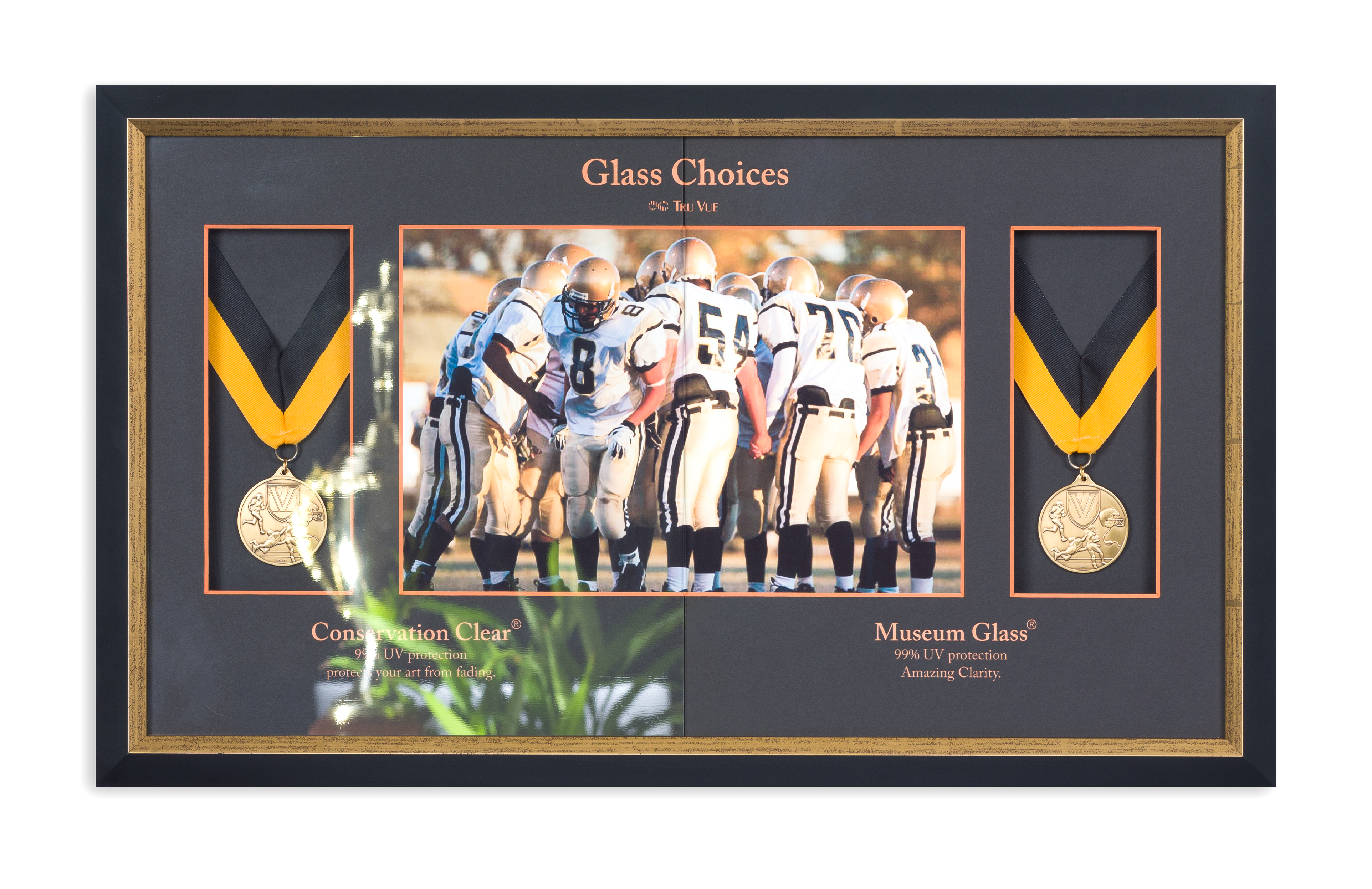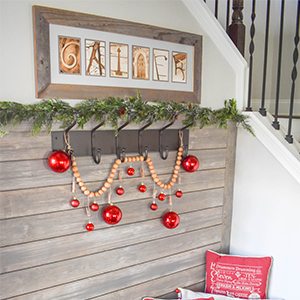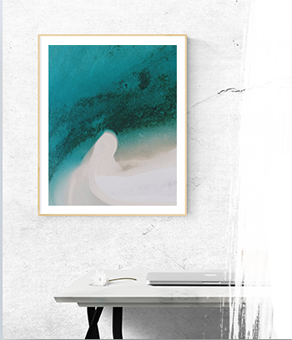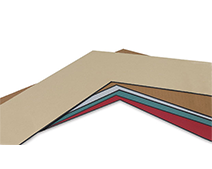How To Choose The Right Glass Option For Your Picture Frame
What is glazing?
Glazing refers to the glass or acrylic that is used in framing to cover your project. A good way to think of glazing is like a security guard for your artwork since it guards and protects from damaging outside elements, like dust and UV damage. Therefore, when it comes to choosing your custom framing materials, glazing plays a critical role in the framing package.
In the design options for our custom framing selections, glazing is one of the last choices you have to make. Yet, this doesn’t mean your glazing should be an afterthought. Art To Frames has one of the largest online glazing selections to help you pick the right glazing for your project. In this blog, we will cover some questions to think about when framing that will help you make the best glazing selection.
How much do you value the piece you’re framing?
If the piece you are having custom framed has either monetary or sentimental value, you should consider your glazing wisely. Since you are investing in framing, most likely the item you are showcasing means something to you, and you don’t want it damaged. At the very least, you likely have some emotional attachment to your piece, even if it’s just something you happen to like the look of. In this case, you’ll want to choose the best protection- conservation-grade glazing.
To be considered conservation-grade, the glazing must have over 97% UV protection to protect your artwork from UV damage like fading or yellowing. UV damage that occurs from both natural and artificial light can significantly damage artwork, photographs, fabric, and other items people tend to frame. UV rays can impact a piece hung in even indirect light, so most frames should include conservation-level glazing. At Art To Frames, we offer multiple choices of conservation-grade glazing that all have 99% UV protection (the best protection available) to help prevent irreversible UV damage.

The image on the left is a real-life example of a photograph with UV damage; when you compare this image with the restored photograph on the left, you can see the severity of damage and what can happen if you do not properly protect your artwork with Conservation Grade Glazing.
How large is your project?
The size of your framing project will help you determine if glass or acrylic is the right choice for you. A good rule of thumb to use is any framing project that is over 36”x48” should be glazed with acrylic.
Acrylic is a great choice for larger projects as it is much lighter than glass and shatterproof, making it easier to hang and extra security in case of breakage.
Glass is an ideal choice for smaller projects under 36”x48”, especially Tru Vue® Museum Glass®, which is our premium glass offering. Museum Glass has 99% UV protection and an anti-reflective coating that makes the glass almost invisible; allowing all the great details of your piece to be seen without any distracting reflections. This is Art to Frames the best option in terms of protection and display, but we also have other options that deal with the annoying glare that may diminish your views, such as non-glare glazing.
Compare these two Elvis posters and you can see how distracting reflections can be and how they obstruct the view.
 This framing project is a split glazing feature that has Conservation Clear® on the left and Museum Glass® on the right. Both these glass options have 99% UV protection – but Museum Glass is anti-reflective almost eliminating the distracting reflections.
This framing project is a split glazing feature that has Conservation Clear® on the left and Museum Glass® on the right. Both these glass options have 99% UV protection – but Museum Glass is anti-reflective almost eliminating the distracting reflections.
How detailed and deep is your project?
The above question has important considerations when choosing between our anti-reflective options or our non-glare options. Both of these glazing options help eliminate unwanted reflections so you can enjoy your piece without distractions. But these glazing options are inherently different when it comes to how they hinder reflections and glare, making it important to the details in your piece and the depth of the project.
And no, we don’t mean depth by how serious your project is, we mean how deep is the framing job. Will your project use more than two matboards, or is it a shadow box type of project? If you answer yes to either of these questions, we highly recommend choosing anti-reflective glazing vs. non-glare glazing for your project.
This is because anti-reflective glazing has a special coating that not only makes it seem like there is no glass or acrylic on the piece but also helps bring out the details and brightens colors -enhancing the artwork. Conversely, non-glare glazing is chemically etched to create a matte finish that scatters light to reduce unwanted glare, like all matte finishes this dulls the details and colors along with the glare.
Non-glare glazing is a great option to use if the artwork is not too detailed, or colorful, or is a shallow framing project.
Any framing job that will have more than two mat boards deep is not recommended, as the further away the glazing gets from the artwork, the more pronounced the matte finish and the fuzzier the artwork will appear.
Where do you live?
Beyond just where your piece will be displayed, consider your home environment. People with a home filled with windows will want anti-reflective benefits as well as conservation-grade protection. Certainly, sunnier locations call for this kind of protection, but because damaging UV rays exist even in cloudy skies; artwork in any room with windows should be protected.
Apartment dwellers may be more prone to moving and want the durability of acrylic. Likewise, people living in areas where there are earthquakes or hurricanes may appreciate its strength and feel more comfortable framing it with acrylic instead of glass.

No matter which you decide to use, acrylic or glass, for your project; if you don’t want your memories to fade, remember to protect it from UV damage by choosing Tru Vue® Conservation Grade Glazing with 99% UV Protection. This image shows the fading that happens with UV damage on the left side; the right side has been protected with conservation glazing.
At Art To Frame, we carry several different types of glazing options to suit your needs in both glass and acrylic.
Tru Vue® Conservation Clear® Glass and Tru Vue® Conservation Clear® Acrylic offer 99% UV protection, the highest in the industry. To address the interference of glare, Tru Vue® Reflection Control® Glass and Tru Vue® Reflection Control® Acrylic significantly reduce glare. This glazing also is offered with conversation benefits such as Tru Vue® Conservation Reflection Control® Glass and Tru Vue® Conservation Reflection Control® Acrylic. Finally, Tru Vue® Museum Glass® is 99% UV-protective and provides unmatched reflection-free clarity.
When you place your order, you will be given the option to choose your glazing. Consider the above question and Live Chat with one of our representatives who will help you make the best decision for your project.


















